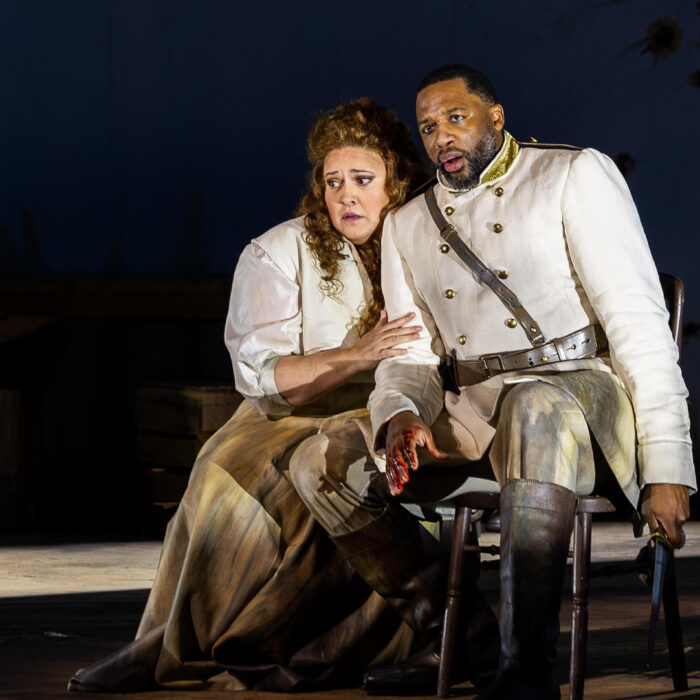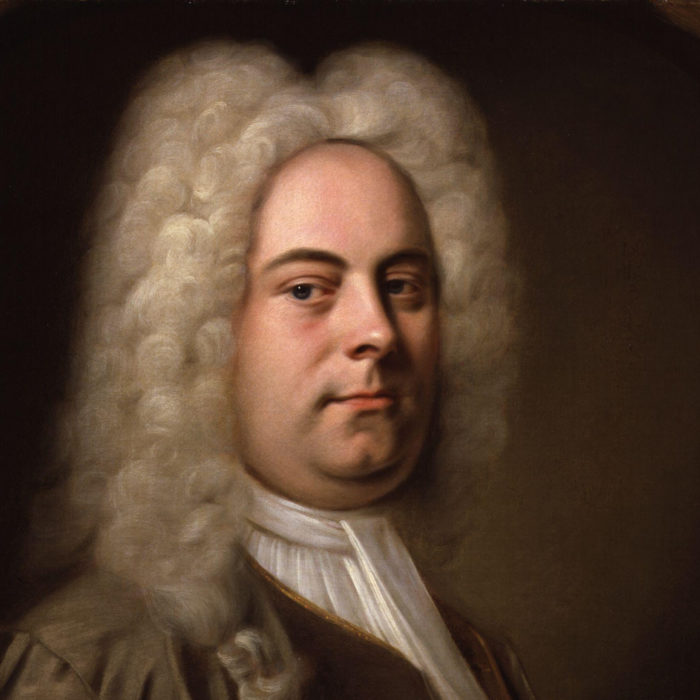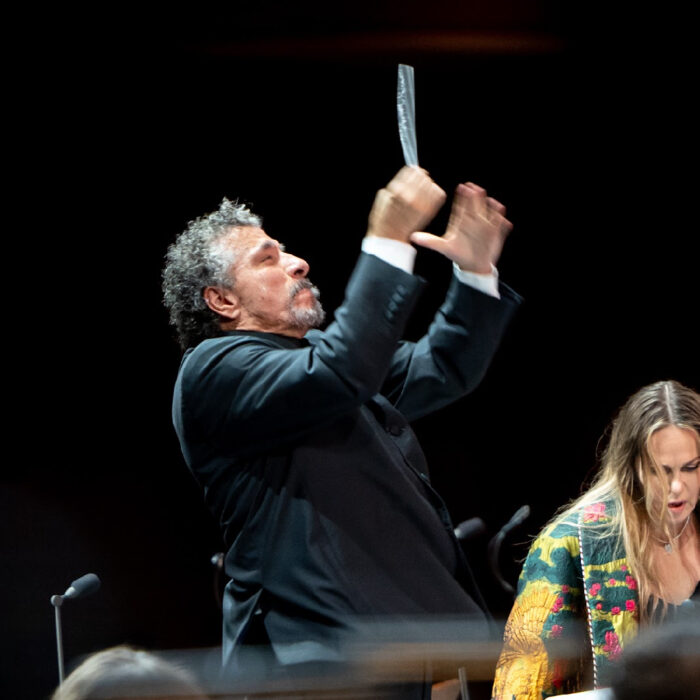
Teatro La Fenice 2023 – 24 Review: Bajazet
Ceresa’s Direction Misfires to Leave A Hollowed Out Shell
By Alan Neilson(Photo: Michele Crosera)
Having laughed, smiled and clapped its way through the opening night of Teatro La Fenice’s production of Vivaldi’s “Bajazet,” the audience greeted the artists at the final curtain with warm applause. However, it was not a reaction shared by everyone; the final notes had barely been played before some members of the audience were beating their way to the exits, while others could not even manage to return following the interval.
Some readers may well be wondering exactly what the audience could possibly have found funny about a drama focused on the abuse of power, attempted murder, humiliation, manipulation and suicide. “Bajazet” is, after all, a grim tragedy that, apart from the final scene in which the conflicts are resolved and Tamerlano indulges in an act of clemency, has absolutely nothing that could be seen as happy, let alone comedic. Agostino Piovene’s libretto moves from one dramatically distraught and disturbing scene to the next, occasionally interspersed with expressions of higher sentiment, but one would be hard pushed to identify anything that resembles comedy.
The director, Fabio Ceresa, did not see it in this way.
A Misplaced and Confused Staging
“Bajazet,” written in 1735, is a pasticcio, a work comprised of new arias, older arias composed for Vivaldi’ earlier operas and arias taken from works by other composers. Although approximately 80 percent of the music is considered to have been written by Vivaldi, Ceresa found the musical numbers to be dramatically distinct and disconnected from the recitatives and, therefore, unrelated to the drama. In his program notes, he states that “the music wants to communicate nothing other than a suspended moment of beauty, an absolute episode of mastery and skill.”
His solution was to treat the recitatives and the musical numbers separately.
The staging, designed by Massimo Checchetto, was arranged as if it were a rehearsal room, with just a few chairs and music stands against a black background. During the overture, the singers took their seats and made themselves comfortable, chatting quietly. All wore black casual clothing and sang from a score. The opening passages of recitative were then delivered in a suitably dramatic manner. Throughout the performance, all the recitatives were staged in this way, which Ceresa believed would bring the narrative to life, unhindered by the distraction of the dramatic unsuitability of the arias.
It failed miserably!
The problem, of course, was what to do with the arias and other musical numbers. Ceresa decided to treat each of them as an entr’acte, totally unrelated to the drama, so that after a few minutes of recitative, a black screen, situated closely behind the singers, would open to reveal a stage with scenery, set up for the relevant singer, who would now be dressed in a colorful costume designed by Giuseppe Palella, to deliver their aria. As soon as they had finished, the screen would close, and the recitatives would continue. It would be impossible to exaggerate how far removed these scenes were from the drama itself. They ranged from a sadomasochist parlor to an evening trip along Venice’s canals, from a domestic kitchen scene to the streets of Jack the Ripper’s London and even to the far reaches of outer space. They had no connection to each other; they stood alone. There were over 20 musical numbers presented in this way. Dramatically, it was indeed a pasticcio; there was no coherent narrative outside the recitatives, which became increasingly difficult to follow as the scenes chopped and changed but without any relevance. To make matters worse, some of the scenes were amusingly or interestingly presented, which only further detracted from the narrative as one’s thoughts were taken into unrelated areas.
The longer the opera went on, the more pointless and tiresome the whole enterprise became. Any members of the audience hoping to see a performance of “Bajazet” would have been very disappointed as the drama disappeared into what Ceresa described as “a rich buffet in which each tray has its own speciality that differs from all the others in terms of ingredients and preparation.”
On the positive side, it was a very colorful production in which Checchetto’s sets and Palella’s costumes, along with videos by Sergio Metalli and lighting designs by Fabio Barettin, created some splendid mise-en-scénes. Bajazet’s aria “Veder parmi, or che nel fondo” was set under the sea with Bajazet in a deep-sea diver’s outfit against a watery background full of fish and bubbles, which then transformed into outer space, set among planets and stars. It was very impressive. Tamerlano sang his aria “In si torbida procella” while riding a motorbike down the motorway, which captured the energy of the music. It was all totally irrelevant to the drama, but it was pleasing on the eye.
Also, Ceresa did manage to bring a degree of coherence by having the “rehearsal” turn into a bit of fun, with the singers watching each others’s “onstage” performances and offering encouraging applause. It gave the appearance of a rehearsal for a variety show.
Ultimately, however, it was a deeply flawed staging. The negativity it generated could not help but fill the mind with negative thoughts, which inevitably spilled over into how one related to the music. It fell to the unfortunate Federico Maria Sardelli, the Vivaldi expert, to keep the musical side of the production on track and to overcome the shortcomings of the production.
Sardelli is Unable to Overcome the Stagings Shortcomings
It all started very positively. Eliciting a vibrant reading from the Orchestra del Teatro La Fenice, Sardelli attacked the opening movement of the sinfonia, capturing its rhythmic energy and the immediacy of its melody before moving on to a graceful and delicately fashioned second movement and a bouncy, stately third movement. However, as the evening progressed and the production became more difficult to accept and, therefore, more tiresome, the perception of the music could not help but become tarnished. Of course, this was not the fault of Sardelli, the singers or the orchestra, who pressed on valiantly. On occasions, the music was so gripping that it did manage to fully overcome the staging; Idapse’s aria, Anche il mar par che sommerga,” being a notable example, and there were others.
Contralto Sonia Prina’s energetic and expressive delivery of her recitatives successfully created a layered portrait of Tamerlano that convincingly brought out his hot-tempered, changeable nature, which was both demanding and authoritative. Normally, one expects plenty of vocal fireworks from Prina, but the role availed her of few opportunities and was, therefore, more restrained, but she nevertheless fashioned pleasing renditions of her arias. Riding her motorbike in “In si torbida procella,” she captured, both visually and vocally, her wild search for a safe haven in a storm, while in “Barbaro traditore,” the pretense that she was Tamerlano was completely abandoned as she played the role of a wife deceived by her husband, with a heavily accented rendition clearly depicting her heartfelt sense of betrayal.
Baritone Renato Dolcini produced a solid, if not forceful, performance as Bajazet. His recitatives were neatly fashioned, although he never really managed to imbue them with the necessary depth of expression. His arias had him performing a variety of roles, which included, among others, a samurai warrior and a computer game image. All were given detailed performances with neatly placed embellishments and accents, but he never really cut to the heart of their emotions.
Mezzo-soprano Loriana Castellano produced a mixed performance in the role of Asteria. Her most effective moments were very good; her aria “Stringi le mie catene,” for example, which was set in a sadomasochistic torture chamber, was amusingly played and sung with a mixture of faux aggression and humor, while the aria “Qual furore, qual affano” allowed her to display her pleasing coloratura to good effect. Other arias were less successful, such as in the case of “Amare un’alma ingrata,” which lacked the necessary color and emotional depth to truly convince. Her recitatives were delivered well and managed to capture Asteria’s feisty character.
Countertenor Raffaele Pé appeared to be really enjoying himself hamming up the comedy elements in his arias, especially in “Spesso tra vaghe rose,” in which he appeared to be playing Pavarotti, patting his handkerchief across his brow with increasing distress as he became more and more sweaty as he indulged in energetic coloratura displays. The handkerchieves started to multiply and appear from every pocket. It was beautifully sung and displayed Pe’s fine technique, but all the comedy had absolutely nothing to do with the text and did more to annoy than amuse. It was in singing his recitatives as Andronico that he really displayed his qualities, which he crafted with expressive depth and sensitivity.
Mezzo-soprano Lucia Cirillo gave a splendid performance as Irene, producing wonderful renditions of each of her three arias. Her presentation of “Qual guerriero in campo armato” allowed her to show off her vocal agility with her rapid coloratura runs, leaps and embellishments, which captured her state of high anxiety, while the aria “Sposa son disprezzata” enabled her to display her more sensitive and reflective approach that highlighted her beautiful legato and subtlety in adorning the vocal line. Her recitatives were crafted neatly and successfully carried the emotional meaning of Asteria’s utterances.
Soprano Valeria La Grotta’s performance as Idapse produced the evening’s most exciting presentation of an aria with her stunning rendition of “Anche il mar par che sommerga,” in which she lit up the theater with her complex coloratura runs. Her performance was consistently strong, and her beautiful upper register impressed as did her vocal agility and ability to mould her singing to bring out the emotional force of the arias. She was also attentive to the demands of the recitatives, which were delivered clearly and animatedly.
Ultimately, and despite the positive reaction from a large proportion of the audience, it is a production that will be mainly remembered for its failings rather than its achievements. Ceresa’s heavy-handed approach hollowed out the work so that all that was left was an empty shell. The drama descended into a fragmented, incoherent jumble of musical numbers without an overarching narrative, which had been relegated to the recitatives and become lost among the disparate, unconnected yet colorful stagings. I have always found Ceresa’s direction to be very successful; his productions are normally full of ideas and dramatically strong, which only confirms the view that when a director does not believe in a work, when he cannot commit to what has been written by the composer and librettist, which Ceresa, by his own words, could not, he should step aside.



